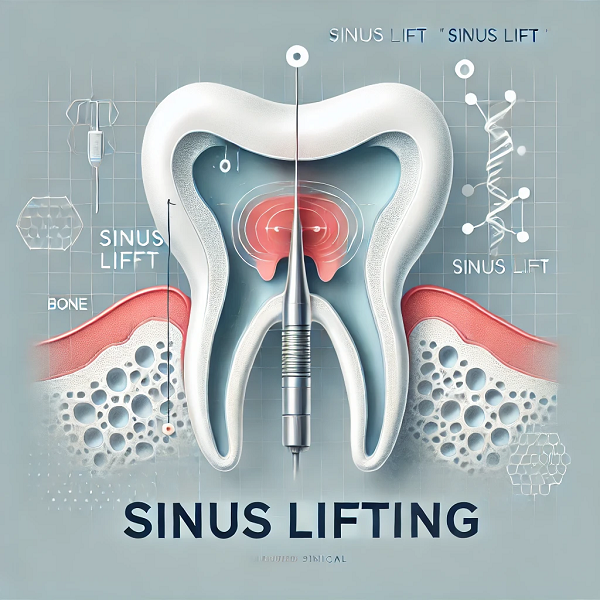Sinus Lifting
Sinus lifting operation is a bone formation technique performed to use a fixed prosthesis when you do not want to use a moving prosthesis in the absence of molars in the upper jaw. Air cavities in the skull that have functions such as reducing head weight and removing sounds properly are called sinus. Due to the loss of upper jaw teeth and delay during prosthetics, the distance between the sinus wall and the crest of the crest is shortened, and there is not enough bone to implant in this area.
Therefore, Sinus Lifting operation is necessary. In patients in need of Implant treatment, if the vertical distance required for the implant in the molar and premolar teeth area of the upper jaw is not sufficient, a Sinus Lifting procedure is performed to increase bone height.
What is Sinus Lifting?
In the Sinus area, the maxillary located just above the upper jaw is called anatomical cavities located near our molars. The task of these cavities near our molars is important as it ensures the formation of sound and the reduction of head weight. As a result of the downward sagging of the Sinus cavities, a number of losses in bone volume occur.
The Sinus grafting process is used to apply implant treatment to toothless areas as a result of filling the sinus cavities that are sagging down. Thanks to this process, it allows you to create enough volume for the length and width of the implant, which must be fully placed in the bone. During Sinus Lifting, local anesthesia and general anesthesia are applied.
How is Sinus Lifting performed?
The area where the operation will be performed is numbed locally, and the gum is removed and a window opens in the sinus with appropriate tools selected for the side operation. The sinus membrane lining the inside of the sinus is gently raised, and bone powder called graft is placed between the lower bones and then the operation area is closed with stitches. After this operation, which lasts about half an hour, slight pain may occur that can pass with painkillers. Implants can be placed during Sinus Lifting operation, as well as implants can be made with a separate operation 2-3 months after Sinus Lifting operation.
After the Sinus Lifting procedure, food should be eaten with the other side for the first 24 hours to protect the wound location. After the procedure, you should not eat or drink anything for 2 hours, and then eat warm and soft things. After sinus removal, you should avoid cleaning the nose with pressure and sneeze with the mouth open. Call your doctor in any suspected case, although it is natural to have bleeding in the form of leakage within 48 hours, the smell of blood or the taste of blood in your mouth. After surgery, it is normal to have swelling. During the first 24 hours, a cold compress should be applied to the operation area from outside via an ice bag. Medications recommended to you by your doctor should be used in a timely manner, without interruption, and as described. Blood thinners should not be used, including aspirin. Call your doctor if there is unexpected bleeding, swelling and pain after Sinus Lifting.
Why is Sinus Lifting done?
Especially in implant applications for the replacement of teeth in the upper jaw, there are some prerequisites for the operation to be completed in a healthy way. It is also one of these conditions that the bone structure, which begins from the place where the jaw ends, has sufficient volume and density. If this hard tissue does not meet the necessary conditions, the implant operation cannot be started directly. In this case, Sinus Lifting operation is performed. If implant treatment is to beapplied to a patient experiencing a decrease in bone volume due to sagging sinuses, Sinus Lifting surgery is applied first. With this process, sufficient volume is created for the length and width of the implant, which must be placed exactly inside the bone. After obtaining sufficient bone volume, implant application is initiated. It is extremely important that maxillofacial surgeons, who are experts in the subject, perform the treatment in implant treatments that require Sinus Lifting.
Sinus Lifting Turkey
If implant treatment is to be applied to a patient experiencing a decrease in bone volume due to sagging sinuses, Sinus Lifting surgery is applied first. Sinus Lifting Turkey is usually done with PRF support. PRF is preferred both because it significantly increases the success rate and because it reduces the waiting time. This operation in Turkey, operate fairly experienced doctors and the success rate is very high.
Sinus Lifting Prices in Turkey
The price of making an implant and the Sinus Lifting prices are the same wherever it is. Bone powder is an imported and expensive material. Sinus Lifting Prices in Turkey vary depending on the material used and the procedure content. To find out the current prices, you should definitely get information from the dentist.
Sinus Lifting FAQ's
We know that you are curious about the Sinus Lifting operation, which is not performed very often. Here're the questions - answers:
What should be considered after Sinus Lifting?
After Sinus Lifting operation, the first rule is strictly forbidden to eat, drink or perform similar actions for two hours. The second rule is to avoid eating with the wound in the eating and drinking process for 24 hours, that is, the area where the treatment takes place. After sinus removal, patients should finally pay attention to the cleaning of the nose.
Is Sinus Lifting Procedure Dangerous?
There is no danger during the time when your dentist is experienced and meticulous. Each operation is dangerous, depending on the quality of the doctor. However dangerous each treatment method is, it is the same for Sinus Lifting operation.

Contact us to find out our cost of Sinus Lifting in Turkey and to get a free quote!